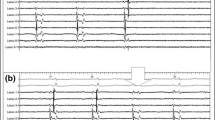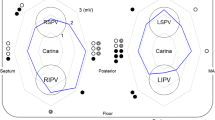Abstract
Purpose
Dormant conduction (DC) induced by intravenous adenosine triphosphate (ATP) after pulmonary vein (PV) isolation (PVI) could predict subsequent PV reconnection (RC) sites. This study aimed to investigate the relationship between the DC and RC sites during the long-term follow-up.
Methods
Ninety-one consecutive patients (62 males; mean age, 62 ± 11 years) with symptomatic persistent (n = 18) or paroxysmal (n = 73) atrial fibrillation (AF) who underwent PVI were included in this study. After a successful PVI, we administered ATP to reveal the DC sites. In total, DC sites were observed in 46 (51 %) patients, and all were left un-ablated after marking or tagging all of them using fluoroscopic images and a three-dimensional (3D) mapping system. After the follow-up period (14.8 ± 3.6 months), AF recurred in 29 (32 %) patients, all of whom had a DC in the initial ablation session, and underwent redo sessions. We divided the DC sites into three groups; in group A, the RC sites differed from the DC sites, in group B, the RC sites were identical to the DC sites, and in group C, the RC sites involved both DC and other sites.
Results
As a result, 20 (69 %), 3 (11.5 %), and 6 (19.5 %) patients belonged to groups A, B, and C, respectively. Statistical analyses comparing the agreement between DC and the RC sites yielded a weak relationship.
Conclusions
DC sites implying RC sites had a weak agreement, and other options to predict RC sites will be required to improve the clinical benefit of CA of AF.




Similar content being viewed by others
References
Gerstenfeld, E. P., Callans, D. J., Dixit, S., Zabo, E., & Marchlinski, F. E. (2003). Incidence and location of focal atrial fibrillation triggered in patients undergoing repeat pulmonary vein isolation: implications for ablation strategies. Journal of Cardiovascular Electrophysiology, 14, 685–690.
Cappato, R., Negroni, S., Pecota, D., Bentivegna, S., Lupo, P. P., Caroleri, A., et al. (2003). Prospective assessment of late conduction recurrence across radiofrequency lesions producing electrical disconnection at the pulmonary vein ostium in patients with atrial fibrillation. Circulation, 108, 1599–1604.
Nanthakumar, K., Plumb, V. J., Epstein, A. E., Veenhuyzen, G. D., Link, D., & Kay, G. N. (2004). Resumption of electrical conduction in previously isolated pulmonary veins: rationale for a different strategy? Circulation, 109, 1226–1229.
Arentz, T., Macle, L., Kalusche, D., Hocini, M., Jais, P., Shah, D., et al. (2004). “Dormant” pulmonary vein conduction revealed by adenosine after ostial radiofrequency catheter ablation. Journal of Cardiovascular Electrophysiology, 15, 1041–1047.
Gula, L., Massel, D., Leong-Sit, P., Gray, C., Fox, D., Segal, O., et al. (2011). Does adenosine response predict clinical recurrence of atrial fibrillation after pulmonary vein isolation? Journal of Cardiovascular Electrophysiology, 22, 982–986.
Miyazaki, S., Kuwahara, T., Kobori, A., Takahashi, Y., Takei, A., Sato, A., et al. (2012). Impact of adenosine-provoked acute dormant pulmonary vein conduction on recurrence of atrial fibrillation. Journal of Cardiovascular Electrophysiology, 23, 256–260.
Fuster, V., Ryden, L. E., Cannom, D. S., The Task Force on Practice Guidelines, American College of Cardiology/American Heart Association: Committee for Practice Guidelines, European Society of Cardiology, European Heart Rhythm Association, Heart Rhythm Society, et al. (2006). ACC/AHA/ESC 2006 guidelines for the management of patients with atrial fibrillation-executive summary: a report of the American College of Cardiology/American Heart Association Task Force on Practice Guidelines and the European Society of Cardiology Committee for Practice Guidelines (Writing committee to revise the 2001 Guidelines for the management of patients with atrial fibrillation). European Heart Journal, 27, 1979–2030.
Dong, J., Dickfeld, T., Dalal, D., Cheema, A., Vasamreddy, C. R., Henrikson, C. A., et al. (2006). Initial experience in the use of integrated electroanatomic mapping with three-dimensional MR/CT images to guide catheter ablation of atrial fibrillation. Journal of Cardiovascular Electrophysiology, 17, 459–466.
Ouyang, F., Bansch, D., Emst, S., Schaumann, A., Hachiya, H., Chen, M., et al. (2004). Complete isolation of left atrium surrounding the pulmonary veins: new insights from the double-Lasso technique in paroxysmal atrial fibrillation. Circulation, 110, 2090–2096.
Matsuo, S., Yamane, T., Date, T., Inada, K., Kanzaki, Y., Tokuda, M., et al. (2007). Reduction of AF recurrence after pulmonary vein isolation by eliminating ATP-induced transient venous re-conduction. Journal of Cardiovascular Electrophysiology, 18, 704–708.
Miyazaki, S., Kobori, A., Hocini, M., Shah, A. J., Komatsu, Y., Taniguchi, H., et al. (2013). Clinical utility of adenosine-infusion test at a repeat atrial fibrillation ablation procedure. Heart Rhythm, 10, 629–635.
Macle, L., Khairy, P., Verma, A., Weerasooriya, R., Willems, S., Arentz, T., for ADVICE Study Investigators, et al. (2012). Adenosine following pulmonary vein isolation to target dormant conduction elimination (ADVICE): methods and rationale. Canadian Journal of Cardiology, 28, 184–190.
Gula, L. J., Massel, D., Leong-sit, P., Gray, C., Fox, D. J., Segal, O. R., et al. (2011). Does adenosine response predict clinical recurrence of atrial fibrillation after pulmonary vein isolation? Journal of Cardiovascular Electrophysiology, 22, 982–986.
Ouyang, F., Tilz, R., Chun, J., Schmidt, B., Wissner, E., Zrem, T., et al. (2010). Long-term results of catheter ablation in paroxysmal atrial fibrillation. Lesson from a 5-year follow-up. Circulation, 122, 2368–2377.
Datino, T., Macle, L., Qi, X. Y., Maguy, A., Comtois, P., Chartier, D., et al. (2010). Mechanisms by which adenosine restores conduction in dormant canine pulmonary veins. Circulation, 121, 963–972.
Miyazaki, S., Kobori, A., Komatsu, Y., Kuwahara, T., Uchiyama, T., Kusa, S., et al. (2012). Clinical implication of adenosine test at repeat atrial fibrillation ablation procedure. Circulation. Arrhythmia and Electrophysiology, 5, 1117–1123.
Author information
Authors and Affiliations
Corresponding author
Rights and permissions
About this article
Cite this article
Okishige, K., Aoyagi, H., Ihara, K. et al. Reappraisal of the clinical implications of adenosine triphosphate in terms of the prediction of reconnection sites in cases with electrical isolation of the pulmonary veins. J Interv Card Electrophysiol 44, 171–178 (2015). https://doi.org/10.1007/s10840-015-0019-z
Received:
Accepted:
Published:
Issue Date:
DOI: https://doi.org/10.1007/s10840-015-0019-z




